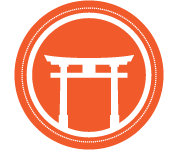Get Curious: What’s on Your Next Exam?
Inryoku Volume 6 Issue 6
By Josh Paul, AOSB Head Instructor
June is kyu exam month at AOSB. Each time we conduct exams, I gain a little insight into what I’m doing and not doing, discussing and not discussing. For example, I’m not spending enough time training katame waza (pinning techniques), and I haven’t sufficiently emphasized the need for independent learning. Aikido has homework.
New Orange Belts
At AOSB, we try to make the promotion requirements as accessible as possible: there’s always a printed copy lying about; there are PDFs on our website; and the requirements are in the dojo’s app. Members have access to over 100 video demonstrations of the kyu/dan requirements, and instructors are always open to student requests. Kyu exams are conducted quarterly, and the classes in the weeks leading up to the exams are focused on exam requirements.
That said, we expect everybody to know all of their written test requirements on test day. That may seem obvious; however, there is a fundamental difference between knowing what is taught in class and knowing your exam requirements. It is not guaranteed that every technique, exercise, or concept that you are expected to know will be taught when you are on the mat. It is entirely up to students to know what’s on their previous and upcoming exams, and to figure out what they know and do not know.
Promotion Requirements in 4 Easy Taps
While it is important to have tangible, achievable goals like preparing for an exam, training only for your next exam isn’t recommended. Exams are not just about learning a specific set of techniques. Exams are also about understanding principles of movement and body mechanics, and developing the skills that make our techniques work.
Fill your practice with curiosity and exploration. The kyu/dan requirements tell a story—it’s a narrative, not a checklist. My Medieval literature professor in college began every lecture with the question, “what is this text trying to convince us of?” What are the kyu requirements trying to convince you of? It’s not “I need to know this technique,” but rather, “why do I need to know this technique, and why now?” What is the skill set that this set of techniques is trying to impart at this point in my practice?
However important kyu and dan exams may be to you, they are not solely about you. As I’ve written before, exams are a dojo-wide opportunity for everybody to improve the frequency, intensity, and quality of their practice, regardless of who is testing.
Exam preparation is an individual and collective process. Individually, the extra effort and training during the months leading up to an exam brings our practice to a higher, more refined level. One person’s preparations can motivate an entire dojo. Exam preparation offers senior students the opportunity to review and reconnect with a dojo’s core curriculum. It gives junior students exposure to what’s to come. When a 7 kyu student is practicing 4 kyu exam techniques, it’ll make that student’s eventual 4 kyu exam easier and better. Exams raise the standard for an entire dojo. [See Inryoku 5:2.]
So, get curious, get prepared, and most importantly get on the mat. It’s your practice: fill it with curiosity and knowledge.



